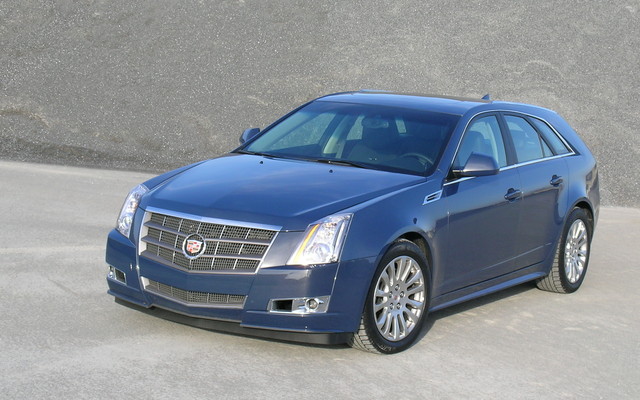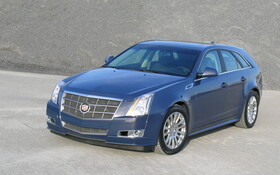2010 Cadillac CTS Sportwagon: Up to the challenge

| Strong points |
|
|---|---|
| Weak points |
|
Wagons aren’t exactly popular, and luxury versions are even less so. In spite of the extremely practical nature of these cars, they were largely ignored in the past in favour of the more macho but a little less practical SUVs that were very much in vogue a few years ago. But times have changed and Cadillac is hoping that the wagon version of its CTS sedan will be a success.
It’s also surprising that the Cadillac division has persevered with this project after all of General Motors’ financial troubles. However, Cadillac seems to be staying the course since they are planning on marketing a CTS-V version of the Sportwagon as well as a CTS Coupe in the summer of 2010.
A sporty look
Cadillac’s stylists wanted to give it a sporty shape while emphasizing loading capacity. With the back seats in place, the baggage hold has a 736-litre (26 ft³) loading capacity and a 1,642-litre (58 ft³) loading capacity with the seat backs lowered, which are exceptional numbers considering that the five-door version is the same length as the sedan. This comparable length allows it to use an identical wheelbase while keeping a simple shape. On the other hand, the sportier lines are the reason that the rear door is relatively narrow and the back seats are designed for medium-sized people at best.
The body has the sharp angles of the sedan and thus respects the unique Cadillac design inspired by the US Air Force’s stealth airplanes. Generally, the transformation from sedan to wagon doesn’t always produce the most aesthetically pleasing results, but this time, at least in my humble opinion, it’s a success. The elegant presentation includes forward-tilted C-pillars, a hatch with V-shaped accents, chrome stripes and vertical tail lights.
It’s an excellent choice for Cadillac’s first wagon in North American. This division’s leadership is convinced that buyers’ tastes are changing and that some of them are going to drop the SUV in favour of the traditional wagon which, in addition to being practical, consumes less fuel than a crossover. In fact, the average fuel consumption of this Cadillac is about 12 litres per 100 km, regardless of the engine you choose.
The silhouette is elelgant mainly because of the proportion of the body features. And yet, despite being essentially the same size as the sedan, the wagon features practically double the loading capacity. Furthermore, the rear has a cargo management system that includes side rails and moveable anchors. The push-button power liftgate comes factory standard and can be programmed to open completely or just three-quarters of the way.
The car that we test drove was reasonably well equipped, although it didn’t have the satellite navigation system nor the rear camera, two nice but costly options. On the other hand, it came with leather seats, an oversized sun roof, a 3.6-litre V6 engine and all-wheel drive. As with all CTS models, whether it’s the sedan or the wagon, the interior is nothing if not luxurious. The metallic satin finish of the central console, the heated and ventilated seats, the stitched leather on the top of the dashboard, the doors, the seats and the stick shift, all indicate that this is a luxury car. And even better, unlike old models, this Caddy offers high quality materials in the passenger compartment and trim that is worthy of the category. And the same goes for the body and the paint
.
As is the current trend, the sun roof is gigantic, but what GM’s engineers are particularly proud of is the roof load management system. Rather than using sills, fasteners and cross members above the roof line, the wagon’s system is integrated with the roof.
Long live the V6!
Until the CTS-V version of this wagon and its more than 500-hp V8 engine arrives, the Sportwagon buyer will have to choose between two fuel injection V6 engines. This injection technology features reduced fuel consumption and diminished emissions, but increased power. A more precise fuel supply makes combustion more efficient. Since fuel consumption is lower, it creates less polluting emissions, including 25% less when cold starting.
The 3.0-litre V6 fuel injection engine comes standard and features 270-hp (201 kW). It also offers variable valve timing to optimize its power and energy output and to reduce emissions. Highway fuel consumption is estimated at 7.0 L/100 km.
The car we test drove was powered by the optional 3.6-litre V6 with fuel injection. It features 304 horses (227 kW) and is paired with the six-speed Hydra-Matic transmission. It was also equipped with the optional all-wheel drive. Note that both of these engines run on regular unleaded gas.
Practical and sporty
This test drive confirmed the first impressions I had after driving the vehicle at the beginning of September in New York. After several hundred kilometres behind its wheel, I found it to be an elegant, practical car with good handling. It’s fun to drive too, despite the over-assisted steering. Plus, the linear stability at high speed is excellent as is the driving position. However, the three-quarter rear visibility is rather poor because of the wide C-pillar uprights.
Our test model came with the FE2 sport suspension, which I didn’t find too firm, even on Quebec roads. This suspension offers a good balance between comfort and handling, which is a testimony to the rigidity of the platform. I should also add that the suspension is also very sophisticated with an independent SLA front suspension with hollow stabilizer bars while there’s a multi-link rear suspension with a completely separate subframe. What’s more, a brace ensures excellent rigidity at the front end.
Thus, the new CTS has all of the sedan’s qualities with greater versatility and a reasonably stylish shape. All-wheel drive enhances its versatility. I should also note that this car can hold its own against what the German and Japanese manufacturers are offering in the category – something you would definitely not have heard me say 10 years ago.
Now it remains to be seen if the public will welcome this new luxury wagon.











